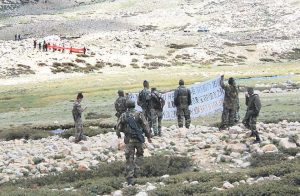
NEW DELHI: In a massive escalation of border tension, at least twenty Indian soldiers, including the commanding officer of an infantry battalion, were killed during a violent confrontation with Chinese troops in Ladakh on Monday night. Indian Army has confirmed the number of casualties.
The incident took place following weeks of rising tensions and the deployment of thousands of extra troops from both sides.
At least 20 Indian soldiers were killed during a violent clash with Chinese troops in the Galwan Valley in eastern Ladakh on Monday night. The casualty number could further rise, according to news agency ANI.
The 20 dead soldiers included an Indian Army officer identified as Colonel Santosh Babu, Commanding Officer of the 16 Bihar regiment, officials said.
It is believed to be first such incident along the contested border with China that Indian armed forces personnel have been killed after a gap of nearly 45 years. Four Indian soldiers had lost their lives in an ambush at Tulung La in Arunachal Pradesh in 1975.
Defence Minister Rajnath Singh briefed Prime Minister Narendra Modi about the situation in eastern Ladakh after he held a high-level meeting with External Affairs Minister S Jaishankar, Chief of Defence Staff Gen Bipin Rawat and the three service chiefs.

The violent face-off between Indian and Chinese military forces took place along the Line of Actual Control (LAC) in Ladakh region amid heightened tensions over the border dispute between the two countries.
The Army said there were casualties on the Chinese side as well but the extent of it was not immediately clear. However New Delhi based TV channels reported that Chinese suffered 45 casualties during the clash.
Official sources said there was no firing between the two sides.
“During the de-escalation process underway in the Galwan Valley, a violent face-off took place on Monday night with casualties.
Hindustan Times reported that rival soldiers exchanged blows, threw stones at each other and Chinese troops even attacked Indian soldiers with rods and nail-studded clubs during the brawl that went on for over six hours. However, this wasn’t the first time the two armies engaged in fisticuffs or used stones and rods to attack each other in the area.
Brawls and face-offs flare on a fairly regular basis between the two nuclear-armed neighbours over their 3,500-kilometre (2,200-mile) frontier, which has never been properly demarcated, but no one has been killed in decades.
Beijing on Tuesday confirmed the incident and accused India of crossing the border and “attacking Chinese personnel”.
Chinese foreign ministry spokesman Zhao Lijian said Indian troops “crossed the border line twice… provoking and attacking Chinese personnel, resulting in serious physical confrontation between border forces on the two sides.”
A large number of Indian and Chinese troops were engaged in an eyeball-to-eyeball situation in Galwan Valley and certain other areas of eastern Ladakh for the last five weeks.
The incident comes days after Indian Army Chief Gen MM Naravane said both sides have begun disengaging from the Galwan Valley.
The Indian and Chinese armies are engaged in a standoff in Pangong Tso, Galwan Valley, Demchok and Daulat Beg Oldie in eastern Ladakh.
A sizeable number of Chinese Army personnel even transgressed into the Indian side of the de-facto border in several areas including Pangong Tso.
The Indian Army has been fiercely objecting to the transgressions, and demanded their immediate withdrawal for restoration of peace and tranquillity in the area. Both sides held a series of talks in the last few days to resolve the row.
Follow this link to join our WhatsApp group: Join Now
Be Part of Quality Journalism |
Quality journalism takes a lot of time, money and hard work to produce and despite all the hardships we still do it. Our reporters and editors are working overtime in Kashmir and beyond to cover what you care about, break big stories, and expose injustices that can change lives. Today more people are reading Kashmir Observer than ever, but only a handful are paying while advertising revenues are falling fast. |
| ACT NOW |
| MONTHLY | Rs 100 | |
| YEARLY | Rs 1000 | |
| LIFETIME | Rs 10000 | |










